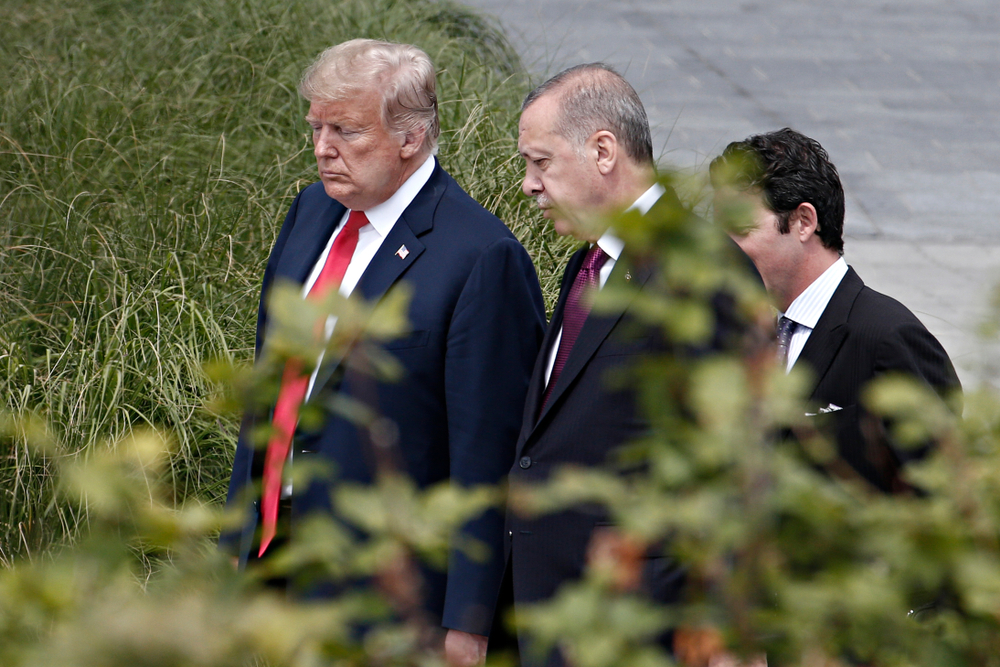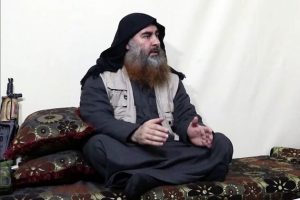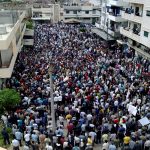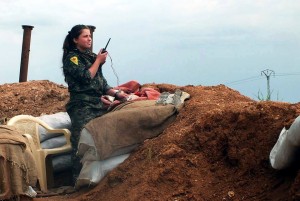by Derek Davison
On December 14, 2018, Donald Trump spoke by phone with Turkish President Recep Tayyip Erdogan. Though U.S.-Turkish relations have been strained in recent years over disagreements around the war in Syria and Turkey’s increasing closeness with Russia, Trump and Erdogan share several personality types—both are temperamental, egotistical right-wing authoritarians—and seem to get along well on a personal level. Several days after that phone conversation, the world got a taste of just how well they get along when Trump declared that he was withdrawing U.S. forces from eastern Syria, upending U.S. policy and the tenuous political situation in that region on the basis of a single phone conversation.
In the days and weeks that followed, Trump saw his planned withdrawal lambasted by his Republican allies in Congress and even by members of his own administration—both Defense Secretary James Mattis and Brett McGurk, Trump’s envoy for the international war against the Islamic State (IS), resigned in protest. Eventually what had been laid out as a fairly rapid withdrawal was instead recast as a partial draw down, and U.S. troops still remain in eastern Syria.
Fast-forward to October 6, 2019, and another Trump-Erdogan phone conversation. The two men spent at least part of their chat discussing the situation in northeastern Syria, where the U.S. and Turkey have been trying, without much success, to create a “safe zone” along the Syrian-Turkish border. Hours after that call ended, the White House announced, as abruptly as it had back in December, that U.S forces would withdraw from the border area and allow Turkey to establish a safe zone entirely on its terms. Once again, on the basis of a single phone call, Trump upended U.S. policy in Syria in a way that threatens to plunge eastern Syria into chaos. For Erdogan, meanwhile, it would seem that his persistence has paid off.
A Gift for Erdogan
There are several things that can and should be said about Trump’s decision. One is that some reevaluation of the U.S. presence in eastern Syria has been long overdue. It was long overdue back in December. What was supposed to be a defined mission to reduce and ultimately eliminate IS’s presence in Syria has been morphing into a very ill-defined, indefinite occupation whose nebulous goals included preventing an IS resurgence, interfering with Iran’s regional plans, and preventing a conflict between Turkey and the Syrian Democratic Forces, the predominantly Kurdish militia that acted as the main U.S. proxy in Syria during the war against IS. For an already overextended United States, another indefinite and poorly defined operation in a country where it was uninvited and unwelcome has been and still is a bad idea.
With that said, another thing that is clear about Trump’s decision is that it represents a betrayal of the SDF and its fighters, who have been a reliable—indeed, the only reliable—U.S. proxy against IS in Syria. The Turkish government regards the Syrian Kurdish Democratic Union Party (PYD)—and especially its People’s Protection Units (YPG) militia, which is the core of the SDF—as a mere rebranding of Turkey’s outlawed Kurdistan Workers’ Party (PKK), with which the Turkish government has been in conflict since the late 1970s (this is an oversimplification, but the two do share organizational ties and ideological affinities). The Turks undoubtedly intend to provoke a military confrontation with the SDF in order to degrade its military capabilities and eliminate any possibility of the group aiding the PKK in its insurgency. The SDF has clearly been expecting the U.S. to defend it from such a confrontation—on Monday it accused the U.S. of failing to “carry out their responsibilities” and described the decision to withdraw U.S. forces from the border region as a “stab in the back.”
More broadly, Ankara regards the large Kurdish presence in northern Syria, along its southern border, as a national security threat. It has already signaled plans to demographically reshape the border in northeastern Syria in line with what it’s already done in northwestern Syria, where Turkish forces occupy the Afrin area and have displaced its Kurdish population in favor of predominantly Arab Syrian refugees repatriated from camps on the Turkish side of the border. Its intention to do so was one of the sticking points in its safe zone negotiations with the U.S. With the U.S. now evacuating its forces from the border area there is nothing to prevent Ankara from replicating its Afrin model along the border, on both sides of the Euphrates River.
A third takeaway is that, while Trump has changed policy, the United States still doesn’t have a coherent reason for keeping forces in eastern Syria. If anything, the case for leaving any U.S. soldiers there is weaker now that we know they’re not there to prevent a conflict between Turkey and the SDF. It’s not even clear what exactly Trump promised to Erdogan in their phone call. Sunday night’s initial White House pronouncement was very matter of fact about a forthcoming Turkish military incursion:
Today, President Donald J. Trump spoke with President Recep Tayyip Erdogan of Turkey by telephone. Turkey will soon be moving forward with its long-planned operation into Northern Syria. The United States Armed Forces will not support or be involved in the operation, and United States forces, having defeated the ISIS territorial “Caliphate,” will no longer be in the immediate area.
The United States Government has pressed France, Germany, and other European nations, from which many captured ISIS fighters came, to take them back, but they did not want them and refused. The United States will not hold them for what could be many years and great cost to the United States taxpayer. Turkey will now be responsible for all ISIS fighters in the area captured over the past two years in the wake of the defeat of the territorial “Caliphate” by the United States.
But then the administration spent all day Monday trying to redefine and/or walk back that statement, with the Pentagon denying that it “endorsed” a Turkish invasion and making it clear that, if an invasion is forthcoming, the U.S. will not play any role in it. Things reached a crescendo with a tweet that was remarkable even by Trumpian standards:
As I have stated strongly before, and just to reiterate, if Turkey does anything that I, in my great and unmatched wisdom, consider to be off limits, I will totally destroy and obliterate the Economy of Turkey (I’ve done before!). They must, with Europe and others, watch over…
— Donald J. Trump (@realDonaldTrump) October 7, 2019
What does Donald Trump consider to be “off limits”? It’s unlikely he’s thought that far ahead. Knowing what we know of Trump, his standard will probably change from day to day, or moment to moment. Which could make for an even more chaotic Syrian policy–and an even greater likelihood of escalation–moving forward.
What Happens Now?
There have been conflicting reports as to whether or not Turkey has already begun its invasion. The Jerusalem Post reported Monday evening that Ankara’s offensive was underway, with airstrikes targeting SDF positions in northeastern Syria. But the outlet later corrected its story, based on a report from the Syrian Observatory for Human Rights that said Turkey had actually struck PKK targets in northern Iraq. Turkish officials later clarified that they struck targets along the Syria-Iraq border so as to prevent Iraqi Kurds from sending supplies or reinforcements to Syria.
Nevertheless, a Turkish offensive is coming. And since the SDF now finds itself in imminent danger of an attack with no hope of U.S. protection, it will undoubtedly look elsewhere for allies. There is, ultimately, only one party to which the SDF can turn—the Syrian government. The SDF has had intermittent contact with Damascus over the past several months but so far its demands for regional autonomy have been too much for Bashar al-Assad to abide. We don’t know how far those talks advanced, but surely SDF leaders saw this day coming. Even if they chose to ignore Washington’s long history of using and then abandoning Iraqi Kurds, Trump himself has already tried to abandon them once before, and it has always been hard to envision the U.S. backing the Syrian Kurds in a conflict against a fellow NATO member, if it came to that. So it’s conceivable that an agreement between Damascus and a much weaker SDF could come together fairly quickly. Indeed, by Tuesday morning SDF officials were already talking about the possibility of cutting a deal with Damascus and its Russian patron.
The main side effect of a Turkish invasion is likely to be on the campaign to eradicate IS. While the group’s “caliphate” has been eliminated from the Syria-Iraq region, tens of thousands of its fighters, their families, and other supporters are believed to still be alive and active, an estimated 30,000 of them in one SDF-run displaced persons camp at al-Hol. For some time now it’s been apparent that pro-IS sentiment is not going away, incubated at al-Hol and fueled by the SDF’s own abuses and its unpopularity in predominantly Arab towns and cities like Raqqa. Would-be caliph Abu Bakr al-Baghdadi just last month released an audio message calling upon his supporters in eastern Syria to, among other things, free those held captive at al-Hol.
Without U.S. support there is no reason for the SDF to continue devoting resources toward maintaining the al-Hol camp, which raises the possibility that thousands of hardened IS fighters—many of them foreign recruits—could be freed. The Trump administration has made it clear that it expects Turkey to assume responsibility for securing those captives and preventing an IS resurgence, but Ankara has never prioritized the anti-IS mission and there’s no reason to believe it will start doing so now. An IS resurgence would invariable lead to calls for the U.S. to re-entangle itself in Syria, presumably the opposite of Trump’s intent, though without the SDF or another proxy in place it’s difficult to imagine how the U.S. will be able to maintain even the forces it currently has there.
Jeremy Konyndyk, senior fellow at the Center for Global Development, argued that the burden of this U.S. policy shift is likely to fall disproportionately on the civilian population of the region:
The President’s decision to abruptly draw down U.S. forces and signal U.S. acceptance of a Turkish military incursion into Northern Syria is incredibly reckless and destabilizing. While many commentators are rightly focusing on the security implications of this policy reversal, the humanitarian implications will be equally enormous. All across Northern Syria, hundreds of thousands of displaced and conflict-affected people who survived the horrors of the [IS] era will now face the risk of new violence between Turkish and SDF forces.
Turkey’s longstanding desire to create a “safe zone” along the border also raises enormous concerns. “Safe zone” approaches are rarely an effective way to protect civilian populations, and if carried out poorly such zones can actually put a population in greater danger. Turkey may also use the zones as a pretext for involuntarily expelling (or “refouling”) thousands of Syrian refugees who have found safety inside Turkey–which is prohibited by international law.
For the U.S., meanwhile, Trump seems intent on leaving some U.S. forces in eastern Syria for the time being, for reasons that remain even less clear than they were before. Without the SDF, not only does the rationale for leaving those troops in place largely disappear, but logistically it’s difficult to imagine how they can possibly remain in place. Maybe Trump’s persistence is also about to pay off.
Updated to include comment from Konyndyk.






There are a few elephants in that room, e.g.:
— Ankara has every incentive to absorb those ISIL fighters and sic them on the SDF.
— ISIL (and al Qaeda) in Syria were a joint project of the U.S., Saudi Arabia, Qatar, and the UAE. Indeed, the U.S. is still protecting ISIL fighters in the al Tanf border crossing area.
— While muttering about the dangers of an Iran land bridge to the Mediterranean via which Iran would supply Hezbollah (from the Israeli viewpoint), the precipitating event for the U.S. intervention in Syria was the announcement of an agreement to build the “Friendship Pipeline” from the South Pars/North Dome Gas-Condensate fields in eastern Iran via Iraq and Syria to Lebanon for export to Europe. This is why the U.S. took up a blocking position at the Al Tanf border crossing between Iraq and Syria along the only highway from Iraq to Syria. And it’s why the U.S. Deep State wants to maintain the presence of U.S. troops there.
Any analysis that fails to address such major factors is faulty.
The analysis is right in signalling that the centre of the problem is the Kurd’s situation left in their own hands in front of a determined Turkey with a U.S. not having apparently any leverage to negotiate an orderly withdrawal. Turkey has its own ‘problem’ with the Kurds plus a huge number of Syrian refugees around 7 million people and need desperately to find a way for them out. Only the geographical location seems at odds. This should be a matter of a mandatory international agreement between the parts involved, something utterly absent in this moment. Also the sort of the around 90,000 former ISIS families and warriors under SDF supervision is left unresolved. Many of these ‘prisoners’ are foreign nationals many of them having been rejected by their countries of origine with Europe unwilling to be part of any solution. Whatever the scenario could be, it’s by itself an impossible task for any of the parties implicated if it’s left alone.
At the moment, improvisation looks to be the way to go, nothing strange in Trump’s mind. A recipe for disaster however. Turkey, U.S., the Europeans wash their hands… and Syria with Russia the ‘broker’ look exceeded, resourceless…